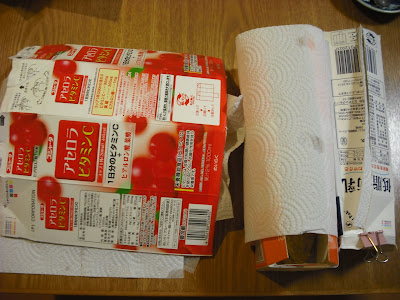Today, I made two attempts to use rice flour in cooking.
今日は、米粉(こめこ)を料理に2回使ってみました。
Attempt 1: I used rice flour as part of tempura batter. I didn't measure the amounts accurately, but I used about 30% rice flour and 70% wheat flour.
テスト1: 天ぷらの衣の一部として米粉を使いました。正確に量を測ったわけではありませんが、だいたい米粉を3割、小麦粉を7割使いました。
I also tested the tip I learned recently: Keep tempura warm after deep-frying.
また、最近知った技を試しました。天ぷらを揚げた後に保温するということです。
I used an empty milk carton and some paper towels.
空き牛乳パックとクッキングペーパーを使いました。
Attempt 2: I used rice flour to make karaage, instead of one part kakakuriko (potato starch) and one part wheat flour, which I usually use for coating.
テスト2: 唐揚げを作るのに、いつもは片栗粉と小麦粉を1:1で使うのに米粉を使いました。
I kept both tempura and karaage warm until serving them.
天ぷらも唐揚げも出すまで保温しました。
Here they are:
ここです。
I can't say I like the texture. I think I need some adjustments.
食感がいいとは言えません。ちょっと調整が必要だと思います。
Subscribe to:
Post Comments (Atom)



7 comments:
Thank you, Hiroyuki. It's a very practical post.
I have lots of rice flour and I think I have used it maybe five times in the past two years... Among the dishes I tried were mochi cakes. I must try another recipe because I didn't like them.
I have made karaage with potato starch and cornstarch and I think actually I preferred the cornstarch version. Have you ever tried it?
The warm tempura tip is very clever! Whenever I deep fry anything in several batches, I put a baking dish in he oven, put it at the lowest temperature and gradually transfer my food there. Aji tempura tastes perfect, but shrimps get soggy... Karaage is perfect too, not to mention korokke!
(Oh, no! I should go on diet instead of thinking about deep-fried food!)
Sissi: Believe it or not, using rice flour in cooking has become popular only recently in Japan. I'm not talking about joshinko 上新粉, which has been used for centuries to make wagashi (Japanese confections), but komeko 米粉, which differs from the former in particle size. Komeko is of about the same particle size as wheat flour, so it can be used as a substitute for wheat flour.
I will elaborate on komeko in another post when I feel comfortable using it.
I've never used cornstarch for karaage. I've bought cornstarch only one in my life to make custard cream! Cornstarch is rather expensive in Japan.
Your oven method sounds terrific! Maybe I could use my toaster oven to do the same job. I learned this "keep warm" tip from the famous TV program, Tameshite Gatten, on NHK. The guest in the program was Mr. Kondo of Tempura Kondo (one of the most famous tempura restaurants in Japan) himself! I will elaborate on his tempura making techniques after I test them myself.
I've heard of using mochiko to make tempura batter before, but any other kind. Usually if I need to use a gluten free flour/starch for breading/battering something, I go with mochiko, katakuriko, or a combination of the two.
Cheryl: Thanks for your comment. I don't know where you live, but in Japan, mochiko is rather expensive and is mainly used to make sweets.
The komeko (rice flour) I find at a JA (Japan Agricultural Cooperatives) supermarket is inexpensive, and I will use it in more dishes from now on.
The word mochiko is usually used in Kansai (Western Japan), whereas the word gyuhiko is used throughout Japan.
Hiroyuki, it's also very convenient to heat plates in the oven before serving. Especially in the Winter when after ten minutes the plates and the food are cold (but really at the minimum temperature: mine is 50°C).
Sissi: Thank your for another wonderful idea. I don't have an oven, so I think I'll try to heat in a microwave or in a toaster oven.
Hiroyuki, I live in California. Mochiko costs about $2 for a 1 pound box (450 grams). The most commonly available mochiko here is grown and milled here in California. It's generally cheaper than katakuriko or even cornstarch.
As for calling it mochiko, over here that's how it's labeled, and personally, the Japanese that I do know is influenced by my grandmother (from Kyoto) and from my grandfather (whose parents were from Hiroshima and Kagoshima).
Post a Comment